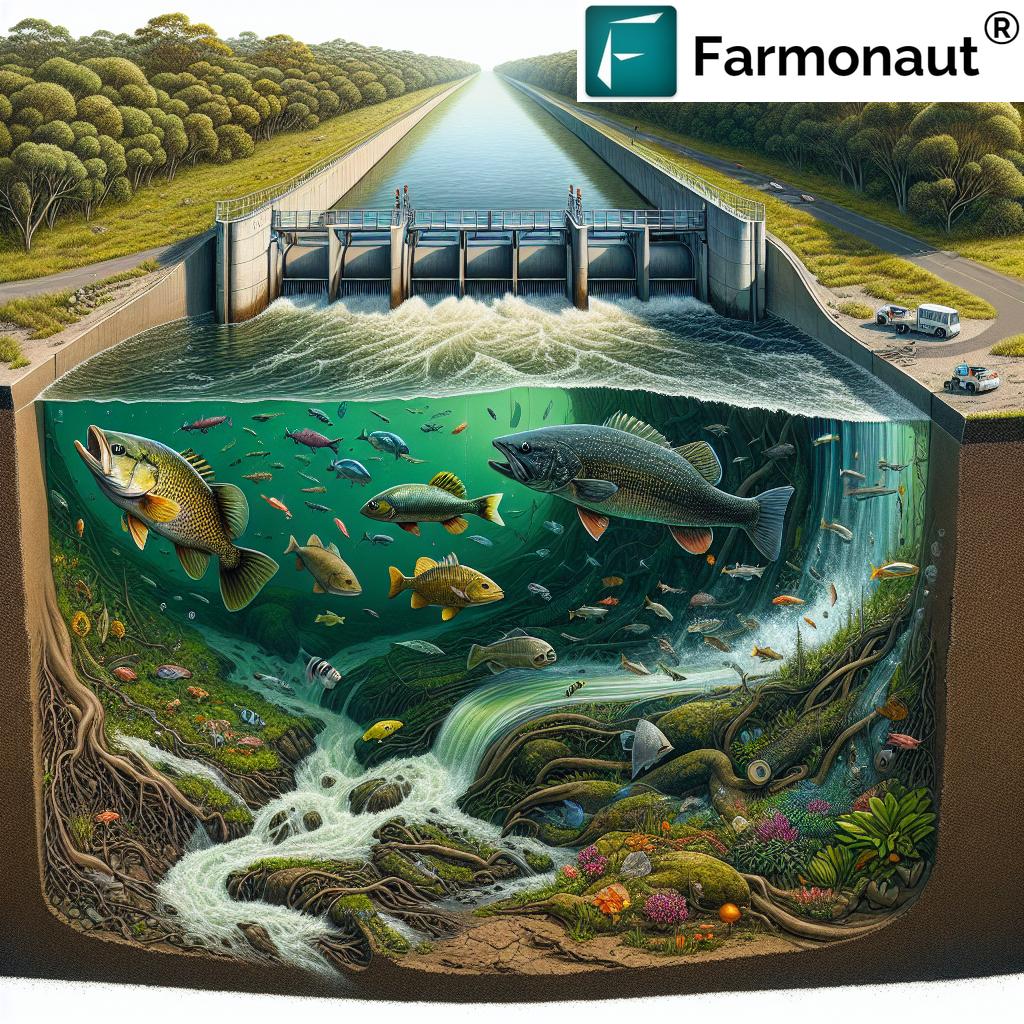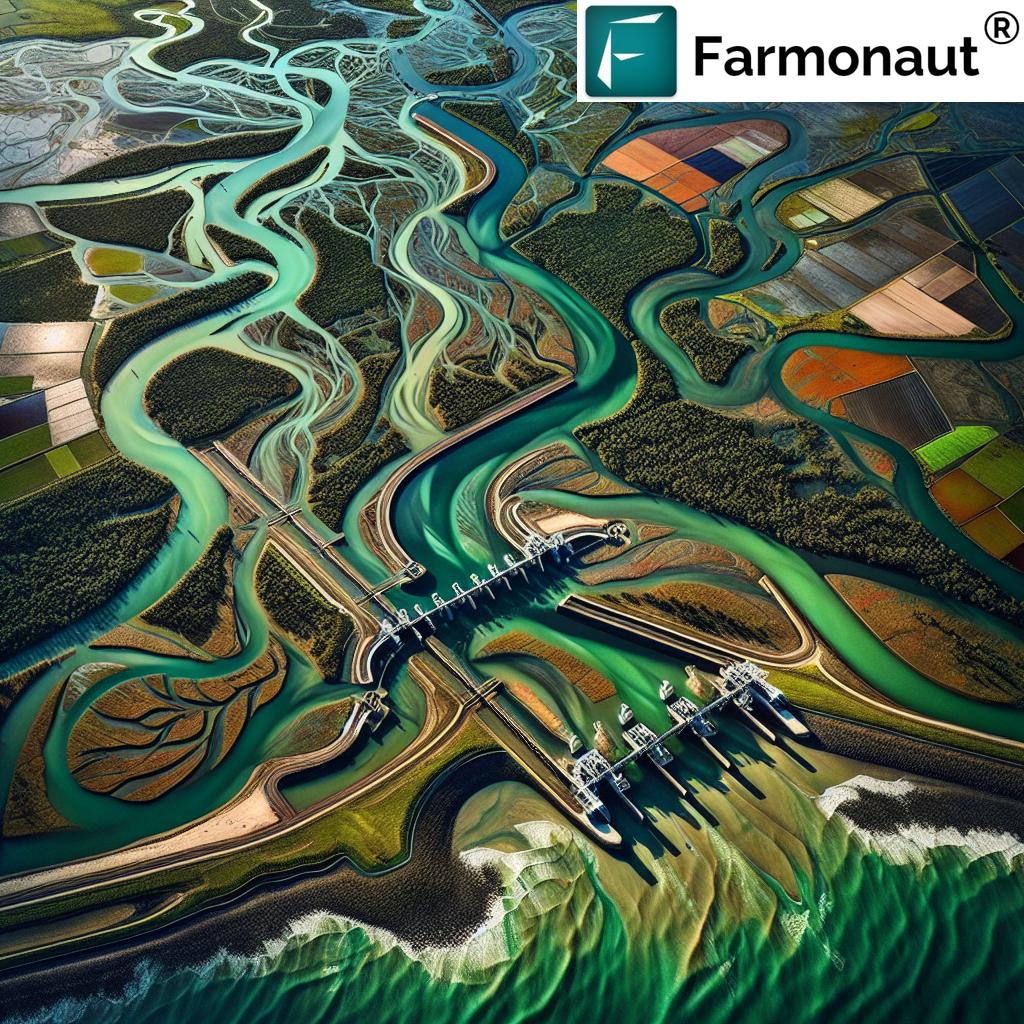Restoring Native Fish Habitats: Overcoming Barriers for Sustainable Waterways in NSW
“Over 10,000 barriers to fish passage exist in NSW waterways, impacting native species migration.”

In the vast and diverse waterways of New South Wales (NSW), Australia, a silent crisis unfolds beneath the surface. Our native fish species, integral to the health and biodiversity of our aquatic ecosystems, face an unprecedented challenge: the proliferation of fish passage barriers. These obstacles, both natural and man-made, are disrupting the delicate balance of our waterways and threatening the survival of numerous fish species. In this comprehensive exploration, we’ll dive deep into the world of fish passage barriers, their impact on native Australian aquatic ecosystems, and the innovative solutions being implemented to restore waterway connectivity.
Understanding Fish Passage Barriers
Fish passage barriers are obstacles that prevent or hinder the movement of fish species within waterways. These barriers can take many forms, from large-scale structures like dams and weirs to smaller impediments such as road crossings and culverts. The impact of these barriers extends far beyond simply blocking fish movement; they disrupt entire ecosystems, affecting biodiversity, water quality, and the overall health of our rivers and coastal waterways.
Types of Fish Passage Barriers
- Physical Barriers: Dams, weirs, floodgates, and road crossings
- Hydrological Barriers: Changes in water flow and velocity
- Chemical Barriers: Poor water quality, including acid sulfate soils
- Behavioral Barriers: Turbulence, noise, or light that deter fish movement
Each of these barrier types presents unique challenges to fish passage and requires tailored solutions for effective remediation.
The Importance of Fish Migration
Fish migration is a critical aspect of the life cycle for many native Australian species. It serves several essential purposes:
- Breeding and spawning
- Accessing food resources
- Avoiding predators
- Adapting to seasonal changes in habitat conditions
When fish passage is impeded, these vital processes are disrupted, leading to declining fish populations and reduced biodiversity in our waterways.
Impact of Barriers on Native Fish Species
The presence of barriers in our waterways has far-reaching consequences for native fish species. Some of the most significant impacts include:
- Fragmentation of fish populations
- Reduced genetic diversity
- Limited access to critical habitats
- Increased vulnerability to predation and disease
- Altered water quality and temperature regimes
These effects are particularly pronounced for species that require long-distance migrations, such as the Australian bass and the endangered Macquarie perch.
Case Studies: Urban Catchments and the Namoi Region
To better understand the impact of fish passage barriers, let’s examine two contrasting case studies: urban catchments and the Namoi region.
Urban Catchments
In urban areas, the high density of infrastructure creates numerous challenges for fish passage. Our studies have shown that:
- Road crossings and culverts account for approximately 80% of fish passage barriers in urban catchments
- Stormwater management structures often create unsuitable flow conditions for fish movement
- Urban development has led to the channelization and concreting of many natural waterways, reducing habitat quality
The Namoi Region
In contrast, the Namoi region presents a different set of challenges:
- Large-scale irrigation infrastructure, including dams and weirs, significantly impact fish movement
- Agricultural practices have led to increased sedimentation and changes in water quality
- Floodplain management structures alter natural flow regimes, affecting fish breeding cycles
“Road crossings and culverts account for approximately 80% of fish passage barriers in urban catchments.”
The Surprising Role of Road Crossings and Culverts
While large dams and weirs are often the most visible barriers to fish passage, our research has revealed that road crossings and culverts play a surprisingly significant role in impeding fish movement, especially in urban and peri-urban areas. These structures can create barriers through:
- Excessive water velocity
- Insufficient water depth
- Large vertical drops
- Debris accumulation
Addressing these smaller-scale barriers is crucial for comprehensive fish passage management.

Innovative Solutions for Fish Passage Remediation
Addressing fish passage barriers requires a multifaceted approach. We’re excited to share some of the innovative solutions being implemented across NSW:
1. Fish-Friendly Culvert Design
New culvert designs incorporate features that facilitate fish passage, such as:
- Baffles to reduce water velocity
- Natural substrate to provide resting areas
- Improved alignment with the natural stream channel
2. Fishways and Fish Ladders
These structures provide a series of stepped pools that allow fish to navigate around larger barriers like dams and weirs. Recent advancements include:
- Vertical-slot fishways for a wide range of fish species and sizes
- Nature-like bypass channels that mimic natural stream conditions
3. Floodgate Management
Innovative floodgate designs and management strategies are being implemented to improve fish passage while maintaining flood protection:
- Tilting gates that allow for tidal exchange
- Automated systems that open gates during specific tidal conditions
4. Barrier Removal
In some cases, the most effective solution is the complete removal of obsolete barriers. This approach:
- Restores natural stream processes
- Provides immediate benefits to fish populations
- Often improves overall ecosystem health
Ongoing Projects and Future Directions
Across NSW, numerous projects are underway to address fish passage barriers and restore waterway connectivity. Some key initiatives include:
- The NSW Fish Passage Strategy, which aims to remediate high-priority barriers across the state
- Collaborative efforts between government agencies, universities, and community groups to assess and prioritize barrier remediation
- Research into the cumulative impacts of multiple barriers on fish populations
- Development of decision-support tools to optimize barrier removal and remediation efforts
These projects demonstrate our commitment to sustainable fisheries management and aquatic habitat conservation.
The Role of Technology in Fish Passage Management
Advancements in technology are playing a crucial role in our efforts to manage fish passage barriers. While our focus is on restoring native fish habitats, it’s worth noting how technology is revolutionizing various aspects of environmental management. For instance, Farmonaut’s satellite-based monitoring solutions have applications in land use management and water resource tracking, which can indirectly benefit aquatic ecosystems.
In the realm of fish passage management, we’re leveraging technologies such as:
- Remote sensing for barrier identification and assessment
- Acoustic telemetry to track fish movements and assess barrier impacts
- 3D modeling and computational fluid dynamics to optimize fishway designs
- Environmental DNA (eDNA) sampling to monitor fish populations non-invasively
These technological advancements are enhancing our understanding of fish passage issues and improving the effectiveness of our remediation efforts.
Challenges and Opportunities in Fish Passage Remediation
While we’ve made significant progress in addressing fish passage barriers, several challenges remain:
- Funding constraints for large-scale remediation projects
- Balancing fish passage needs with other water management priorities
- Addressing the cumulative impacts of multiple barriers in a catchment
- Climate change impacts on water availability and fish habitat
However, these challenges also present opportunities for innovation and collaboration. By working together across sectors and disciplines, we can develop holistic solutions that benefit both our native fish populations and the communities that depend on healthy waterways.
Comparative Analysis of Fish Passage Barriers in NSW Waterways
| Barrier Type | Prevalence | Impact on Fish Migration | Potential Solutions |
|---|---|---|---|
| Dams | 5% | High | Fish ladders, dam removal, trap and transport |
| Weirs | 15% | High | Vertical-slot fishways, rock ramps |
| Floodgates | 10% | Medium | Automated systems, tilting gates |
| Road Crossings | 40% | Medium | Bridge upgrades, improved culvert designs |
| Culverts | 30% | Medium to High | Baffles, natural substrate installation |
The Way Forward: A Call to Action
Restoring native fish habitats and overcoming barriers for sustainable waterways in NSW is a complex challenge that requires ongoing commitment and collaboration. As we move forward, we must:
- Continue to prioritize and implement barrier remediation projects
- Engage with local communities and stakeholders to build support for fish passage initiatives
- Invest in research and monitoring to assess the effectiveness of our interventions
- Integrate fish passage considerations into broader water management and infrastructure planning
- Adapt our strategies to address emerging challenges, including climate change impacts
By taking these steps, we can work towards a future where our native fish species thrive, and our waterways support healthy, resilient ecosystems for generations to come.
Conclusion
The restoration of native fish habitats and the removal of barriers in NSW waterways is a critical endeavor that touches on multiple aspects of environmental management and conservation. As we’ve explored, the challenges are significant, but so too are the opportunities for positive change. By combining innovative technologies, collaborative approaches, and a deep understanding of aquatic ecosystems, we can make substantial progress in restoring the health and connectivity of our waterways.
While our focus has been on fish passage, it’s important to recognize that these efforts contribute to broader environmental goals. Just as Farmonaut’s agricultural solutions aim to promote sustainable land management practices, our work in aquatic habitat conservation seeks to create a more balanced and resilient environment for all.
As we continue this important work, we invite all stakeholders – from government agencies and researchers to local communities and industries – to join us in the effort to restore our waterways and protect our precious native fish species. Together, we can create a sustainable future for NSW’s aquatic ecosystems and the diverse life they support.
FAQ Section
- Q: What are the most common fish passage barriers in NSW?
A: The most common fish passage barriers in NSW include road crossings, culverts, weirs, dams, and floodgates. Road crossings and culverts are particularly prevalent in urban catchments. - Q: How do fish passage barriers affect native fish populations?
A: Fish passage barriers can fragment populations, reduce genetic diversity, limit access to critical habitats, increase vulnerability to predation and disease, and alter water quality and temperature regimes. - Q: What solutions are being implemented to address fish passage barriers?
A: Solutions include fish-friendly culvert designs, fishways and fish ladders, innovative floodgate management, and in some cases, complete barrier removal. Technological advancements such as remote sensing and acoustic telemetry are also aiding in barrier assessment and remediation. - Q: How can local communities get involved in fish passage restoration efforts?
A: Local communities can participate in citizen science programs, support local catchment management authorities, and advocate for fish passage considerations in local infrastructure projects. - Q: What are the long-term benefits of restoring fish passage in NSW waterways?
A: Long-term benefits include improved biodiversity, healthier aquatic ecosystems, more sustainable fisheries, and enhanced recreational and economic opportunities related to healthy waterways.
For more information on sustainable land management practices and agricultural solutions, visit Farmonaut’s web application or explore their API services.
















